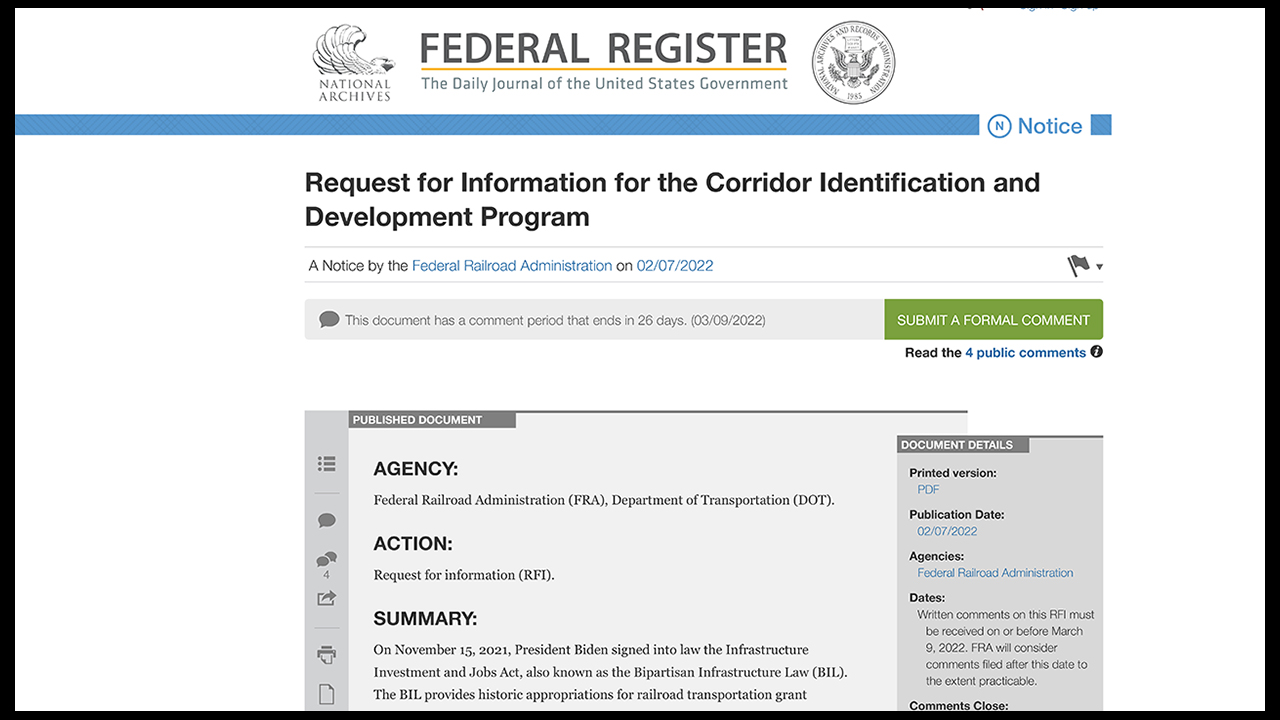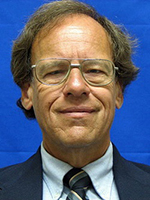
Passenger Rail Dollar Bills From BIL: Apply Now
Written by David Peter Alan, Contributing Editor
If you run the sort of organization that has the know-how to manage a passenger rail corridor, the ability to get some money together but need more, and an available stretch of railroad that could accommodate such a corridor, this is your chance to tell the FRA about it and apply for a grant to get that line started.
The agency announced that opportunity in the Federal Register, where federal agencies publish their announcements. The three-page document bears the citation 89 Fed.Reg. 6938, and its FRA Docket Number is FRA-2022-0006. Its headline is “Request for Information for the Corridor Identification and Development Program,” and the agency is accepting proposals until March 9.
The program at issue is authorized by the Infrastructure Improvement and Jobs Act (IIJA), passed on Nov. 15, 2021 and also known as the Bipartisan Infrastructure Law (BIL). The Summary in the Notice gave the background: “The BIL provides historic appropriations for railroad transportation grant programs administered by the Federal Railroad Administration (FRA), and also authorizes new programs to enhance rail safety and to repair, restore, improve and expand the nation’s rail network. Among those new programs is the Corridor Identification and Development Program (the Program), which creates a new framework to facilitate the development of new, enhanced, and restored intercity passenger rail corridors throughout the country.”
As the new statute requires, the FRA will establish the program by March 22 under DOT auspices. The Notice continued: “In this Request for Information (RFI), FRA is seeking comments on the Program and how it can best serve stakeholders and the public in facilitating the development of intercity passenger rail corridors.” The Notice includes information on how to submit information, and a more-extensive “Background” section with questions that the agency expects respondents to consider and answer.
The program is authorized under §22308 of the BIL. As the Notice stated: “The Program includes: (1) A process for eligible entities to submit proposals for the development of intercity passenger rail corridors; (2) a process for FRA to review and select such proposals; (3) criteria for determining the level of readiness for federal financial assistance of intercity passenger rail corridors; (4) a process for preparing service development plans (SDPs); (5) the creation of a pipeline of intercity passenger rail corridor projects; (6) planning guidance; and (7) such other features as FRA considers relevant.”
Who Can Participate?
While the list of potential respondents appears broad, it is restricted to certain types of entities. The notice listed them: “While FRA has a central role in the administration of the Program, the BIL also calls for important roles for other parties—including States, Amtrak, host railroads, labor organizations, and other stakeholders—who typically have responsibilities in intercity passenger rail development efforts. For example, Amtrak, States, groups of States, entities implementing interstate compacts, regional passenger rail authorities, regional planning organizations, political subdivisions of a State, federally recognized Tribes and other public entities, as determined by FRA, are all eligible to submit proposals for the development of intercity passenger rail corridors under the Program.”
Conspicuously absent from the list are rider-advocacy organizations at the national (e.g. the Rail Users’ Network (RUN) and Rail Passengers’ Association (RPA) and state or regional levels. It appears that only organizations that have some sort of “official” political standing or currently operate a railroad (including Amtrak) are eligible, not citizens’ organizations that lack such standing. The reason for that restriction appears to be that the entity in question must be able to raise the money to develop any proposed corridor: “In addition, in partnering on the preparation of an SDP, FRA must partner with the entity that submitted the proposal, relevant States and Amtrak, as appropriate, and also must consult with Amtrak, appropriate State and regional transportation authorities and local officials, employee labor organizations, host railroads and other stakeholders, as determined by the Secretary.”
FRA Questions
Respondents are asked to define the appropriate roles for Amtrak and the FRA in developing the corridors and proposing Service Development Plans (SDPs). Those SDPs must include: “(1) A detailed description of the proposed intercity passenger rail service; (2) a corridor project inventory, identifying the capital projects necessary to achieve the proposed intercity passenger rail service and the order in which Federal funding will be sought; (3) a schedule, and any associated phasing, of projects and related service initiation or changes; (4) project sponsors and other entities expected to participate in carrying out the plan; (5) a description of how the corridor would comply with Federal rail safety and security laws, orders, and regulations; (6) the locations of existing and proposed stations; (7) the needs for rolling stock and other equipment; (8) a financial plan; (9) a description of how the corridor would contribute to the development of a multi-State regional network of intercity passenger rail; (10) an intermodal plan; (11) a description of the anticipated environmental benefits; and (12) a description of the corridor’s impacts on highway and aviation congestion, energy consumption, land use, and economic development.” The Notice also contains more questions about SDPs and other issues.
Other Provisions
The FRA must submit an annual Project Pipeline to Congress with information about project prioritization and funding. Regarding funding, the Notice says: “The statute includes three examples of activities that may be undertaken using this funding, including: (1) Providing funding to public entities for the development of SDPs selected under the Program; (2) facilitating and providing guidance for intercity passenger rail systems planning; and (3) providing funding for the development and refinement of intercity passenger rail systems planning analytical tools and models.”
In selecting projects for funding, the FRA must consider the 14 selection criteria enumerated in 49 U.S.C. §25101(c), but respondents are allowed to suggest other criteria that the agency could apply in the selection process. The FRA must partner with the entity that proposed each of the corridors selected for development under the program, but the agency also asked how selective the program should be and “What considerations are relevant for determining the selectivity of the Program?” as the final question presented in the Notice.
This writer and many others who spent time in the Advocacy Community have made suggestions for corridors to Amtrak, state governments, federal agencies, members of Congress and anybody else with power, in the illusory hope that they would listen and get service started. Amtrak proposed its Connect US plan for 2035 last April, when it was met with skepticism from advocates who want more trains (see Amtrak’s 2035 Map: Hopes and Challenges, posted here on April 9, 2021 and A Hard Sell and a Long Shot, posted here on November 16, 2021). The latest pronouncement from the FRA does not even consider those citizen-advocates to be “stakeholders” for the purpose of developing the corridors that potential riders want. Still, this step by the FRA may make funding for new corridors more likely than it had been before. Will this step actually help bring more corridors to fruition, or will it only lead to yet more illusory hope and eventual disappointment? Time will tell, and so will national and local politics.

David Peter Alan is one of America’s most experienced transit users and advocates, having ridden every rail transit line in the U.S., and most Canadian systems. He has also ridden the entire Amtrak network and most of the routes on VIA Rail. His advocacy on the national scene focuses on the Rail Users’ Network (RUN), where he has been a Board member since 2005. Locally in New Jersey, he served as Chair of the Lackawanna Coalition for 21 years, and remains a member. He is also a member of NJ Transit’s Senior Citizens and Disabled Residents Transportation Advisory Committee (SCDRTAC). When not writing or traveling, he practices law in the fields of Intellectual Property (Patents, Trademarks and Copyright) and business law. The opinions expressed here are his own.


